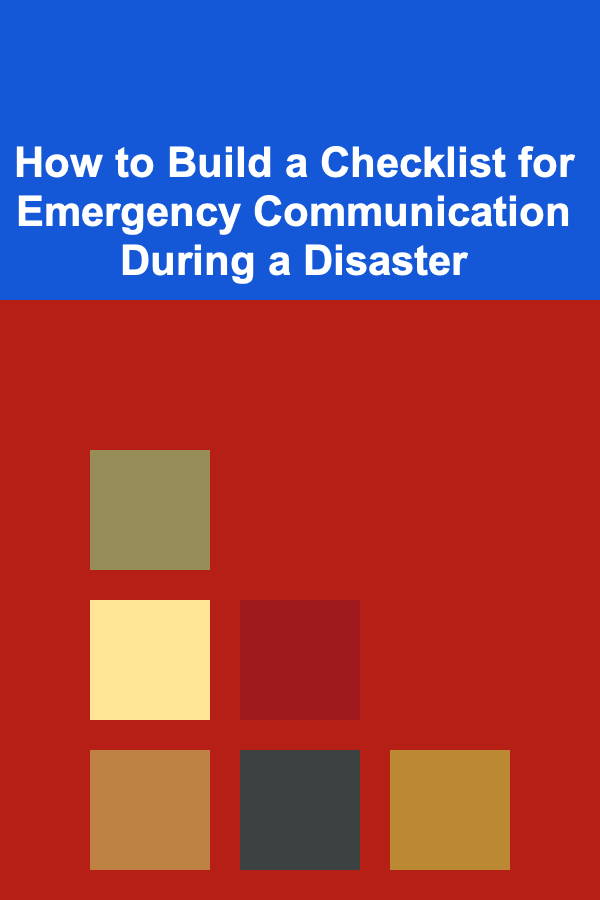
How to Build a Checklist for Emergency Communication During a Disaster
ebook include PDF & Audio bundle (Micro Guide)
$12.99$11.99
Limited Time Offer! Order within the next:

Effective communication during a disaster is critical for ensuring the safety and well-being of individuals and communities. Whether it's a natural disaster, a technological crisis, or a public health emergency, the way information is shared can significantly impact the outcomes of the situation. A well-structured emergency communication plan ensures that all stakeholders---such as first responders, affected individuals, and the public---receive timely, accurate, and actionable information.
In this actionable guide, we'll explore the steps required to create a checklist for emergency communication during a disaster. This checklist will help organizations, local governments, and individuals stay prepared for any emergency situation.
Define Key Communication Objectives
Before diving into the specifics of the checklist, it's important to establish the primary goals of emergency communication. These objectives guide all subsequent actions and help ensure that the information provided is aligned with the needs of the situation.
Key Objectives:
- Ensure Public Safety: The first priority is always the protection of life and property. Communication should focus on evacuation procedures, shelter locations, and safety precautions.
- Provide Clear Instructions: During a disaster, people need specific guidance on what actions to take. The communication should include step-by-step instructions for different scenarios.
- Maintain Transparency: Public trust is essential. Providing accurate, timely updates reduces confusion and helps the community stay calm and informed.
- Coordinate with Response Teams: Communication should also facilitate coordination among emergency services, responders, and other key organizations involved in the response efforts.
Identify and Prioritize Stakeholders
Effective communication is not one-size-fits-all. Different groups require different types of information, and each group must be prioritized based on their needs and role in the emergency.
Stakeholder Groups:
- Public: The general population needs clear, concise, and actionable information. This includes residents in affected areas, commuters, and bystanders.
- Emergency Responders: This group includes first responders such as firefighters, police officers, paramedics, and medical teams. They require detailed and technical information to manage the disaster effectively.
- Government Agencies: Local, state, and federal government agencies need up-to-date data for decision-making, resource allocation, and public messaging.
- Media Outlets: Journalists play a key role in disseminating information to the public. Clear instructions and regular updates are crucial for them to share accurate information.
- Volunteers and Support Teams: Volunteers are essential in many disaster scenarios. These individuals need to know where to go, what tasks to perform, and how to stay safe.
- Businesses: Businesses, especially those providing essential services (e.g., utilities, healthcare), need clear directions to continue operations or shut down appropriately during the disaster.
Establish Communication Channels
In a disaster, different communication channels serve different needs, and not all channels will be functional during a crisis. It's crucial to identify which channels are best for reaching specific groups and ensure that multiple backup channels are available.
Key Channels to Consider:
- Emergency Alert Systems (EAS): Use official warning systems like EAS or Wireless Emergency Alerts (WEA) to broadcast urgent notifications about disasters to a large population.
- Social Media: Social media platforms like Twitter, Facebook, and Instagram can rapidly disseminate information. They also allow for two-way communication, where people can ask questions or report incidents.
- SMS/Text Messages: SMS is highly effective, even in situations where the internet is down. SMS alerts can be used to send brief but vital information directly to people's phones.
- Websites and Mobile Apps: A designated website or mobile app can serve as a centralized location for important updates, evacuation routes, shelter information, and emergency contacts.
- Radio and Television: In cases where internet connectivity is unreliable, radio and television broadcasts are critical for reaching a broad audience with important updates.
- Public Address Systems: In areas where large groups are gathered (e.g., schools, stadiums, public squares), using loudspeakers and PA systems can quickly inform people of emergency procedures.
Establish a Crisis Communication Team
A well-organized team is essential to manage the flow of information during a disaster. The communication team should consist of individuals from various departments, each responsible for specific tasks related to emergency communication.
Roles to Consider:
- Spokesperson: A designated spokesperson is essential to provide consistent and authoritative information to the public and media. This person should be calm, composed, and well-informed.
- Social Media Manager: This person will oversee the organization's social media presence, ensuring that updates are posted regularly and that misinformation is addressed promptly.
- Information Officers: These team members are responsible for gathering data from various sources (emergency responders, government agencies, etc.) and ensuring that the information is accurate and timely.
- IT and Communications Support: In a crisis, technical issues can arise. Having IT support available to manage the flow of information across multiple platforms ensures that communication remains uninterrupted.
- Logistics and Operations: In many cases, responders need real-time information about the movement of people, supplies, and resources. A logistics officer can help coordinate these details to ensure that responders are fully informed.
Create Pre-Formatted Messages
Preparedness is key to a successful emergency communication plan. Pre-formatted messages allow your team to quickly disseminate information without wasting valuable time during a disaster. These messages should be tailored to different audiences, scenarios, and communication channels.
Examples of Pre-Formatted Messages:
- Evacuation Alerts: Clear instructions about where to go, how to get there, and what to bring (e.g., "Evacuate immediately. Shelter located at [address]. Follow route [X] for quickest access.").
- Weather Warnings: Specific information about weather-related hazards (e.g., "Severe storm warning issued. Take shelter immediately. Strong winds expected at [time].").
- Shelter and Resource Locations: Addresses of shelters, availability of food and water, and locations for medical aid.
- Public Health Information: Health guidelines in the event of a disease outbreak or contamination (e.g., "Do not drink water from public sources. Boil water before use.").
- Safety Reminders: Essential safety tips for protecting yourself during a specific disaster (e.g., "Stay indoors. Avoid using electrical equipment until power is restored.").
Ensure Accuracy and Timeliness
During an emergency, the accuracy and timeliness of the information provided are paramount. Delays or misinformation can exacerbate panic, waste resources, or even lead to casualties.
Actionable Steps:
- Verify Information: Double-check all information before it is shared with the public. Rely on trusted sources such as local emergency services, government agencies, and official weather reports.
- Update Regularly: Disaster situations evolve rapidly. Commit to providing regular updates, even if it's just to confirm that the situation has not changed. Regular updates help people stay informed and reduce uncertainty.
- Monitor Information Flow: Continuously monitor all communication channels for feedback, corrections, or signs of misinformation. Act quickly to correct any false information and prevent it from spreading.
Test and Train Your Communication Systems
A well-documented emergency communication checklist is useless if it's not tested regularly. Conducting drills and simulations can help identify weaknesses and ensure that all communication channels function properly during a disaster.
Actionable Steps:
- Run Mock Drills: Simulate different types of emergencies (e.g., hurricanes, wildfires, chemical spills) to practice your communication strategy. This will help your team become more familiar with their roles and improve coordination under pressure.
- Test Technology: Regularly test communication tools, including websites, apps, SMS systems, and radio channels, to ensure they're functional and accessible when needed most.
- Provide Staff Training: Equip your crisis communication team with the skills they need to respond effectively. Regularly train them in crisis communication techniques, media handling, and public speaking.
Evaluate and Improve After Action
After the disaster has passed, it's important to review the communication efforts and evaluate their effectiveness. The lessons learned will help improve your approach for future emergencies.
Evaluation Methods:
- Conduct Post-Incident Reviews: Gather the crisis communication team and relevant stakeholders to assess what went well and what could be improved. Take note of any communication breakdowns and areas for refinement.
- Survey Affected Populations: Ask those impacted by the disaster about their experience with the communication efforts. Did they feel informed? Were the messages clear and actionable? This feedback will provide valuable insights for improving your approach.
Conclusion
A well-prepared checklist for emergency communication is essential for responding to disasters effectively. By defining communication objectives, identifying stakeholders, establishing clear channels, and ensuring timely, accurate information, organizations can reduce the impact of emergencies and save lives. Regular testing and continuous improvement are key to ensuring that your emergency communication strategy is always ready when needed most.
Reading More From Our Other Websites
- [Home Lighting 101] How to Make Your Home Feel Larger with Proper Lighting
- [Home Space Saving 101] How to Maximize Space in a Tiny Apartment
- [Home Maintenance 101] How to Keep Your Plumbing System Running Smoothly
- [Home Storage Solution 101] How to Store Your Collection of Books in a Stylish Way
- [Star Gazing Tip 101] Capturing the Cosmos: Essential Tips for Stellar Night Photography
- [Survival Kit 101] How to Choose the Best Bushcraft Gear for Your Outdoor Skills and Needs
- [Personal Care Tips 101] How to Create a Healthier Home Environment
- [Star Gazing Tip 101] Common Mistakes New Stargazers Make---and How to Avoid Them
- [Organization Tip 101] Best Organization Tools for Meal Planning
- [Personal Investment 101] How to Invest in Commodities for Diversified Exposure

How to Create Memorable Holiday Traditions with Decorations
Read More
How to Maintain Your Equipment to Extend Its Lifespan
Read More
How to Maintain Your Seasonal Wardrobe with Care
Read More
How to Refinance Your Mortgage
Read More
Sketching Buildings and Cityscapes: A Comprehensive Guide
Read More
Choosing the Right Caulk Gun and Applying Caulk Like a Pro
Read MoreOther Products

How to Create Memorable Holiday Traditions with Decorations
Read More
How to Maintain Your Equipment to Extend Its Lifespan
Read More
How to Maintain Your Seasonal Wardrobe with Care
Read More
How to Refinance Your Mortgage
Read More
Sketching Buildings and Cityscapes: A Comprehensive Guide
Read More